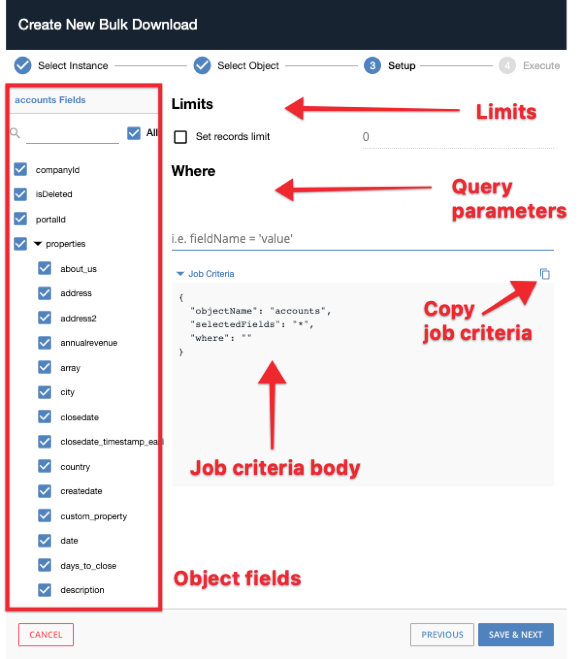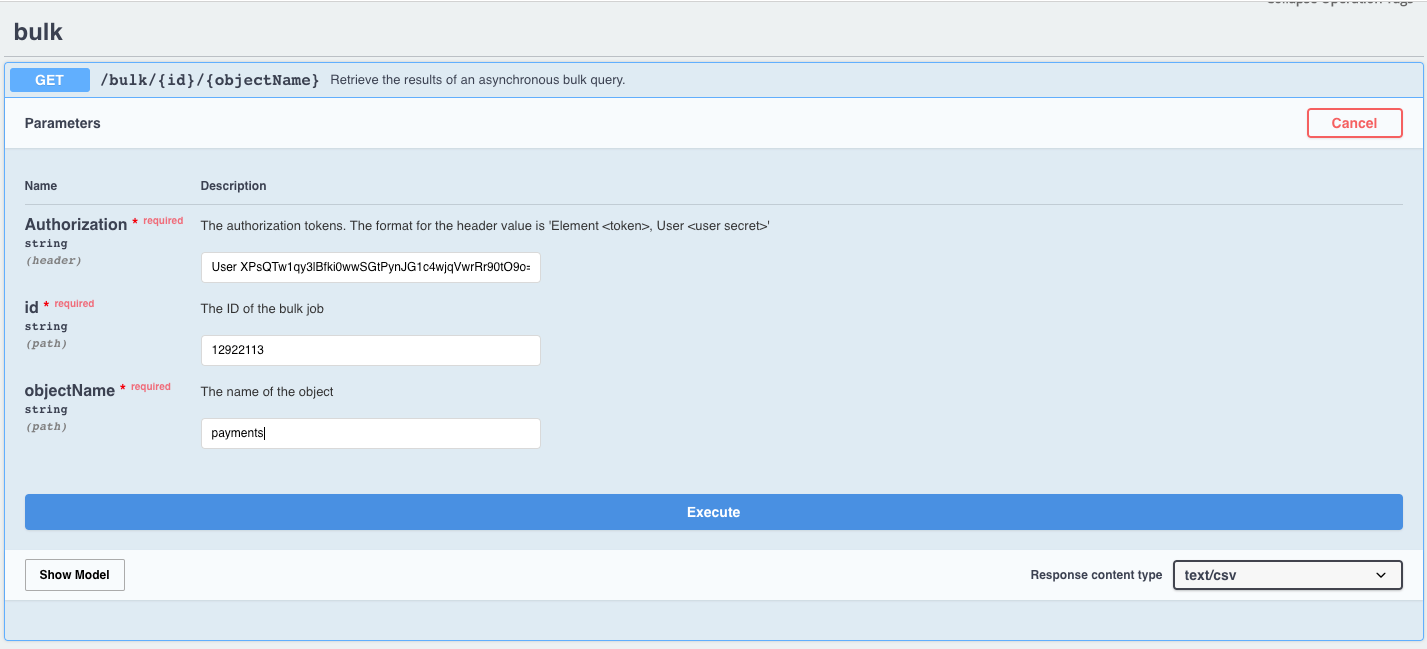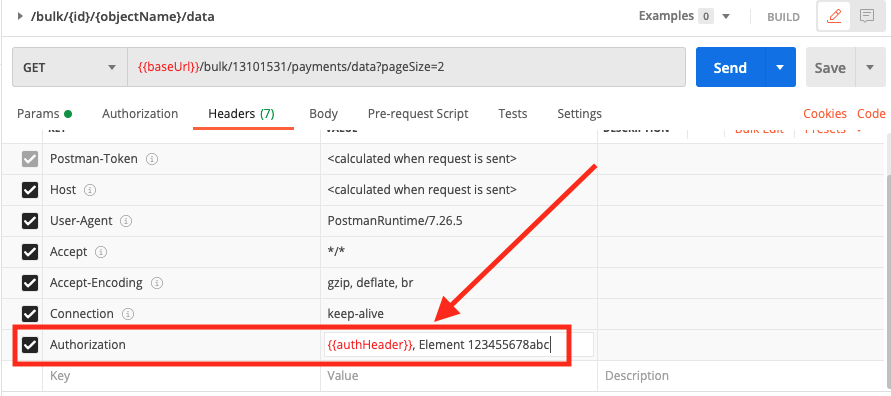In this article, you'll learn how to create bulk download and upload jobs using Cloud Elements's APIs. All bulk APIs are available for catalog elements, and most bulk APIs are available for custom-built or Community elements. If you need to use the POST bulk/download API for a custom or Community element, you must do so outside of the Cloud Elements UI; see our bulk services Postman collection for more information.
Using Bulk via the UI
Accessing the Bulk UI
You can access bulk functionality of the Cloud Elements platform via the UI. To access the Bulk section, sign in to Cloud Elements and select Bulk from the left-side navigation bar.
Starting a New Bulk Download Job
From the Bulk UI, you can start a new bulk download job, the results of which can be downloaded in either JSON or CSV format.
- Sign in to Cloud Elements and navigate to the Bulk UI.
- Click the New Download Job button in the top-right corner. The Create New Bulk Download wizard appears.
- In the Select Instance section, select the element instance you want to create a bulk download job for, and then click Next.
- In the Select Object section, select the object you want to bulk download from, and then click Save & Next. If your new bulk download job is from a virtual data resource, select the checkbox to display available virtual data resources instead of element objects.
- In the Setup section, complete the following:

- Select the object fields you want to download from the list. You can display or hide subfields using the arrows where available.
- If desired, set a limit to the number of records included by enabling Set records limit and entering the maximum number of records you want retrieved.
- If desired, add query parameters in the Where field. Parameters added here must match the fieldName = `value` format.
As you make changes on the Setup section, the contents of the Job Criteria will update accordingly. You can copy the text of the job criteria by clicking the Copy button.Once you have completed setup, click Save & Next.
- When you have completed setup for your bulk download job, click Save & Next.
- On the Summary section, review and confirm the bulk download job details, and then click Execute. Your newly created bulk job will appear in the Bulk menu.
- Once the job has completed, click the job from the Bulk menu. The Bulk job Details window appears.
- Click Download File, and then select if you'd like the download in JSON or CSV format.
Performing a Bulk Download via API
Use bulk download to generate a csv or json file from a large number of records. Since the bulk download works asynchronously, you need to make two calls to download a file.
Step 1: Create a Bulk Job
Cloud Elements currently supports two bulk download APIs:
POST /bulk/query(for all available fields, see the Job Criteria for /bulk/query)POST/bulk/download (for all available fields, see the Job Criteria for /bulk/download)
bulk/download API whenever possible. The only time Cloud Elements recommends using bulk/query is when the vendor endpoint supports native bulk.Both of the above APIs create a bulk job, which builds out a file in Cloud Elements. The bulk/query uses a CEQL query to specify the records included in the file (used for native bulk support), while bulk/download uses a payload with more customization and functionality.
You will need the bulk job's ID from the response body in order to check the status of your bulk job and to download the resulting file once it's complete. The following is an example response body for the creation of a bulk job:
{
"instanceId": 425904,
"id": "42114492",
"status": "CREATED"
}Since the job itself will take an unknown amount of time to complete, you can add a callback URL to the bulk job for both APIs. Once completed, the job makes a callback to the URL and notifies you of its completion.
Example POST bulk/query – cUrl and UI
curl --location
--request POST 'https://staging.cloud-elements.com/elements/api-v2/bulk/query?q=select%20*%20from%20payments%20limit%20100' \
--header 'accept: application/json' \
--header 'Authorization: User jiIDhi88eO2sf7eEfjJIeope9279dA38AJjeiOp124vg14o=, Organization 47902sge72126dfsuIEA124dffhHQdc4, Element fu9U492udsetrptT9CvUfeyiOIieWjq4Uxwmmi4k=' \
--header 'Elements-Async-Callback-Url: https://exampleNotificationURL.com'

Example POST bulk/download Payload
{
"objectName": "MyContact",
"format": "application/json",
"selectFields": "application/json",
"limit": 100,
"apiLimit": 100,
"filterNulls": true,
"from": "2018-09-18T10:56:14.000+0000",
"to": "2020-11-30T10:56:14.000+0000",
"filterDateField":"lastModifiedDate",
"notificationUrl": "https://www.examplenotificationurl.com",
"where": "lastName='Smith'",
"query": {
"includeDeleted": true,
},
"pageSize": 5,
"continueFromJobId": 123456,
}Step 2: Download the Bulk File
To download the results of your bulk job, use the GET /bulk/{id}/{objectName} API. you'll use this same API to retrieve jobs submitted using either POST /bulk/query or POST /bulk/download.
After the job generated from the /bulk/query or /bulk/download call completes, use the GET /bulk/{id}/{objectName} API to download the file. {id} refers to the ID of the bulk job you captured above in step 1, and {objectName} refers to the object name you used to generate the bulk job, eg contacts, accounts, myVDR, etc.

/bulk/query API, the file can be downloaded as a csv or json when you execute the request. For jobs created with the bulk/download API, the file must be downloaded in the format you specified in the payload when you created the bulk job. You must choose the Response Content Type that you specified in the bulk/download payload or you will receive a Bad Request error message.
Performing a Bulk Upload via API
Unlike bulk download, a bulk upload job only requires one call: POST /bulk/{objectName} (for all available fields, see the Job Criteria for /bulk/query)
Example POST /bulk/{objectName} (upload) - cUrl
curl --location
--request POST 'https://staging.cloud-elements.com/elements/api-v2/bulk/payments' \
--header 'accept: application/json' \
--header 'Authorization: User jiIDhi88eO2sf7eEfjJIeope9279dA38AJjeiOp124vg14o=, Organization 47902sge72126dfsuIEA124dffhHQdc4, Element fu9U492udsetrptT9CvUfeyiOIieWjq4Uxwmmi4k=' \
--header 'Content-Type: multipart/form-data' \
--form 'file=@12924282.json;type=application/json'For elements that support upsert, identifierFieldName is passed in the metaData to designate the field to be used for upserts.
.JSON and not in .CSV as the nested fields may not appear in the CSV format.Bulk Services Postman Collection
Currently, the following bulk APIs are not available in the UI (itself not available to all users):
POST /bulk/downloadfor Community and custom elementsGET /bulk/{id}/{objectName}/datafor all elementsPUT /bulk/{id}/previewfor all elements
However, these APIs are available via our bulk Postman collection. This collection contains all of the bulk APIs listed above, whether or not they are available in the UI. Please refer to the Available Bulk APIs table in our documentation, or review the descriptions in the collection for more detailed information.
To import the collection into Postman, click the Import button, select Raw Text, paste the raw JSON from the collection file, and click Continue.
After importing the collection, you will also need to save an environment or environments that include the following:
- A base url parameter (baseUrl)
- In staging, set baseUrl to https://staging.cloud-elements.com/elements/api-v2
- In production, set baseUrl to https://api.cloud-elements.com/elements/api-v2
- An authorization header parameter (authHeader)
- Your authHeader should be formatted as follows (this example is specific to your environment, so double-check if you receive any errors): User {YourUseSecretHere}, Organization {YourOrgSecretHere}
To set an environment in Postman, click the icon to the right of the eye icon.

Click Add, then fill out the following page accordingly, where the gray block stands in for your user secret:

When you are ready to make a call, you will need to add the element instance token of the element instance you’d like to make the call with to your Authorization header, as follows:
{{authHeader}}, Element {InsertYourInstanceTokenHere}
After completing the above, you're ready to make a call to one of the bulk service APIs.
Example cUrl for GET /bulk/id/objectName
curl --location --request GET 'https://staging.cloud-elements.com/elements/api-v2/bulk/13101531/payments' \
--header 'Authorization: User 123456789abc, Organization abcdef123456, Element xyz123456789' \
--header 'Accept: application/json'
Best Practices for Bulk Queries
Bulk queries are a powerful tool to retrieve records in greater numbers than possible when using standard Cloud Elements endpoints. Because of their potential to return large amounts of records, they can often take a long time to complete, making it even more important to utilize best practices when performing queries and fetching their results. Here are a few best practices:
Use the Where Clause
Make sure you are crafting your bulk queries to return only the records you are interested in seeing. For instance, instead of using the query select * from contacts, use select * from contacts where lastModifiedDate > '2018-05-01' to return only those records that were modified after May 1st, 2018. For more information on how to use the where clause, see Querying with CEQL.
Retrieve Only the Columns You Need
Many elements support field selection. In your query, you can list only the columns that you want returned to improve the speed of the bulk job. Fore example, instead of select * from contacts, use select firstName, lastName from contacts where ... to only return the firstName and lastName fields of your contacts. This also minimizes the size of your bulk results file which decreases the time needed to fetch your results. Another way to achieve this is to use a virtual data resource with only the fields mapped that you care about.
Use a Limit Statement
You can easily limit the number of results returned by your query by adding a limit statement. For example, select * from contacts limit 500. This retrieves only the first 500 records returned by the API provider, greatly reducing the time needed for the bulk job to complete if the unlimited query would return many more than 500 records.
Set a Callback URL
When creating a bulk query, you can provide a value for the header Elements-Async-Callback-Url to receive a notification upon the bulk job's completion. The notification also sends information about the bulk job, such as whether the bulk job was successful and the number of records returned. Incorporating this callback URL functionality into your app allows your app to process bulk job results as soon as they are done as well as handle any errors.

